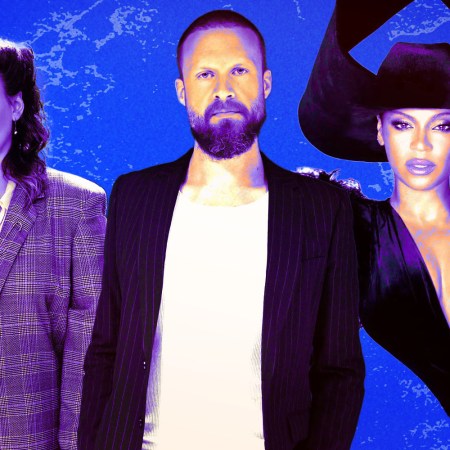As I sit down to write the introduction to InsideHook’s annual predictions list for 2023, I’ve got my self-heating mug of coffee sitting next to my elbow (very 2030), I’m wearing a 100% wool cardigan with wooden toggles (very 1330), and I’ve got COVID and I’m wondering if I’ll test negative in time to be with family this holiday (very 2020…and 2021).
In the last couple of years, the only constant has been uncertainty, a trend that solidified into a norm this past year. Elections that were shoo-ins ended in concession calls. Settled rights were revoked. An unnecessary war began and continues. The worst person on Twitter took ownership of Twitter. No combination of tarot cards, Magic 8 Balls and top-dollar B2B data visualizations could have helped us predict the year that is now in our rear view.
Is the fickle and volatile nature of our 21st century life going to stop us from looking ahead to 2023? Certainly not. For one, the InsideHook trend forecast is an annual tradition around these parts. (If you want to check our work, you can see how we did for 2022 and 2021. No refunds! Oh that’s right, this website is free.) And secondly, we’re keeping our third eye focused on our niche expertise: the lives of American men. We’ll leave the geopolitical projections to organizations that don’t also do Pringles rankings.
We can’t say for sure if you’ll have COVID again this time next year (though the odds are looking good), but after tapping the reporting and prognosticating expertise of our entire editorial staff, there are a few ways we’re fairly certain your life will change in 2023. Twenty ways, in fact.
See you here next year. Same time, same place. Assuming we don’t farm this out to ChatGPT…
— Alex Lauer, Features Editor
1. Social media will enter its flop era (if it hasn’t already)
Believe it or not, social apps might be on the back burner for you in 2023. Social media has entered its flop era. The current digital behemoths are greatly lacking in new ideas and innovation. In turn, users of their platforms are bored. It’s blatant that every social platform steals the successes of its competitors, then inundates its users with similar features they don’t want while refusing to listen to the changes they actually ask for. Take this summer, when Instagram’s CEO told its users that — despite fervent pleas to see more of their friends’ photos on their main feed — the app would continue to push those godforsaken Reels (Instagram’s TikTok knockoff) instead. Meanwhile, Twitter has become an unchecked cesspool of hate since Elon Musk’s acquisition at the end of October. Checking Twitter has become more of a chore than it already was, and many have jumped ship, moving onto platforms like Mastodon. Even TikTok, the video-sharing app whose algorithm has been lauded endlessly for how it keeps its users staunchly engaged, has been accused of getting stale. Does this mean that there will be a mass exodus from social platforms in 2023? Unlikely. (I, for one, will still be scrolling.) But you might start feeling a bit fatigued by the platforms you heavily frequent, which could actually propel you to spend your free time doing something a lot more interesting than checking in on whatever dumb shit Elon Musk is doing. — Logan Mahan, Associate Commerce Editor
2. Indigenous cuisine will get the national spotlight it deserves…
“I think this is just the beginning of something bigger. I’ll say it again, one day Native chefs and Native foods will not be an anomaly.” We couldn’t agree more with chef Jessica Walks First, owner of Chicago’s Ketapanen Kitchen, who said it well in our recent article about authentic Indigenous experiences that have been cropping up across the U.S. And if you’ve been noticing that Indigenous restaurants and culture are receiving more and more well-deserved attention as of late, we’re happy to say that this is only the beginning. Earlier this year, Owamni by The Sioux Chef won the 2022 James Beard Award for Best New Restaurant, and other eateries like Cafe Ohlone in Berkeley and Off the Rez in Seattle are serving both modern and nostalgic Native cuisine to a growing number of interested customers. And the movement goes beyond the culinary landscape. Landmarks — like Havasupai Gardens at Grand Canyon National Park — are being renamed to reflect and honor Indigenous heritage, and Americans are being introduced to more Native characters and storylines in television shows like Reservation Dogs. In 2023, we expect to see even more Indigenous chefs highlighting the true cuisine of North America in delicious ways. Like chef Sean Sherman does at Owamni, these menus will reflect Indigenous ingredients and forgo those of colonization to showcase the true nature of American cuisine. In our opinion, it couldn’t come soon enough. — Amanda Gabriele, Senior Editor
3. …while the new wave of French restaurants will be cool and unstuffy
If you ask the majority of Americans their view on French food, they might use words like “fancy,” “complicated” and “stuffy” when describing the cuisine. But walk into any bistro in Paris or seaside restaurant in the south of France, and that is far from the feeling. Simple, seasonal cooking and convivial atmospheres are the norm there, where people just want to have a good meal and linger over a great bottle of wine. Luckily for Americans, restaurateurs are catching on here in the United States. Sure, there is room for Escoffier- and Bocuse-level excellence, but the everyday Parisian doesn’t eat this way, nor must we to enjoy the beauty of a French culinary experience. Take for example Le Dive, a tabac-inspired natural wine bar with affordable plates of mussels and steak frites, that opened in NYC this year. Or Denver’s Noisette, a restaurant and bakery that serves French fare more akin to the everyday home cook than the bourgeoisie. While fancy French food will always have its place, 2023 will be the year that Americans can go out for hand-cut steak tartare or a perfectly roasted chicken without worrying if they’re using the right fork or what the bill will look like at the end of the night. — Gabriele
Where to Eat, Stay and Travel for Authentic Indigenous Experiences
From Minneapolis to Santa Fe, Native American chefs, producers and artists are finally getting their due4. Studios will finally figure out the formula in our new movie-watching age…
I want to predict a big comeback for theatrical moviegoing in 2023, riding the Avatar wave straight into a box-office bonanza led by John Wick 4, Magic Mike’s Last Dance, Spider-Man: Across the Spider-Verse, a new Indiana Jones movie, and, of course, M3GAN. But given the ongoing pandemic, shifting viewing habits and audiences trained to expect superheroes in movie theaters and everything else on Netflix, I can’t in good conscience make that prediction. I will say, however, that I think studios will begin to more clearly redefine the line between a theatrical release and a streaming release, a distinction that was understandably blurred in the first few years of the pandemic.
For indie movies, the odd combination of increased accessibility and damage to the theatrical model may prove impossible to undo. But I also think that studios that aren’t hyper-fixated on tossing movies into a cash-burning heap of streaming #content might look at what Paramount Pictures had in 2022. Their genre-diverse slate of hits included horror (Scream; Smile), romantic comedy (The Lost City), family-friendly stuff (Sonic the Hedgehog 2) and performance art (Jackass Forever), alongside their massive Top Gun sequel — as well as some smaller stuff that was strategically positioned on VOD and streaming (The Contractor; Senior Year; Significant Other), plus an unabashedly adult-driven theatrical release at Christmas (Babylon). Though the studio’s (delightful) Orphan: First Kill got one of those confusing sort-of-theatrical-also-on-Paramount-Plus releases, for the most part, Paramount seemed to know what it was selling, where it was selling it and why. The convenience and accessibility of streaming can be a major plus, but without something drawing paying customers to theaters, studios enter a nightmare scenario of making a bunch of Kissing Booth-quality glorified TV movies in a vain attempt to goose subscriber numbers on a budget. At least some of the studios will realize there’s money to be made in actually enticing audiences to theaters with a variety of movies that can be enjoyed communally and safely, rather than crossing their fingers about one gigantic tentpole per year. We can hope, anyway. — Jesse Hassenger, Freelance Movie and TV Writer
5. …and they’ll need to, because the streaming bubble will burst
We’ve been saying for years now that there are simply too many streaming services out there, and it seems as though things are finally coming to a head. If 2022 was any indication, 2023 will be remembered as the year the streaming bubble finally burst. Netflix, the one that started it all, has proven increasingly unable to keep up with the competition — and the company endured an especially rough year last year, kicking it off by losing a whopping 200,000 subscribers in Q1. The streamer continued to make headlines for a number of baffling business decisions, including cracking down on password sharing, launching an ad-based tier and abruptly canceling many of their beloved original series before they had a chance to build an audience. Of course, the most confounding decision recently was their choice to only allow Glass Onion: A Knives Out Mystery to play in theaters for one week over Thanksgiving, leaving hundreds of millions of dollars on the table.
But they’re not the only streaming service making boneheaded moves to try and save a buck or two. Since its merger with Warner Bros. Discovery, which resulted in mass layoffs, HBO Max has been canceling shows left and right (including the excellent Minx, despite the fact that the show had previously been renewed and was almost done filming season two) to cut costs and — most upsettingly — pulling old seasons of its original programming off of its service. That’s not only a slap in the face to fans who want to revisit their favorite shows; it’s downright devastating for the creators who spent years of their lives working on something only to have it completely vanish and be left with no hard copy of it. Look for this to become a bigger issue in 2023 as more and more showrunners lobby for streaming services to provide them with hard copies of their work or guarantee it won’t be unceremoniously scrubbed from the platform. And, perhaps, look for more folks in the industry to turn their attention away from streamers and back to cable or even traditional broadcast networks for a bit of stability. — Bonnie Stiernberg, Managing Editor
Our Favorite TV Shows of 2022
From hilarious comedies to riveting drama and whatever the hell “The Rehearsal” was, this is what we couldn’t stop binging this year6. MLB rule changes will create new stars…
On the heels of the designated hitter being made universal in both the American and National League last season, Major League Baseball is making big changes to the game in 2023 that are meant to improve the pace of play, increase player safety and inject some action into a sport that could sorely use some juice. In addition to some minor tweaks, there are four major MLB changes: a pitch timer, a limit on pickoff attempts, defensive shift restrictions and bigger bases. The play alterations that go into effect on Opening Day on March 30 should lead to some big changes at the All-Star Game on July 11 in Seattle as the batting averages of players who put the ball in play should skyrocket thanks to the elimination of the shift. If those players are fast, they should be able to steal more bases in 2023 than in prior years because their targets will be larger and pitches will be limited in how often they can attempt to pick them off. Power will still be important, of course, but contact hitters who are able to spray the ball all over the field and make things happen on the basepaths are going to see their stats spike, especially if they’re fast. Hitting .300 and being able to steal a base used to be important. Now, finally, maybe they will be again. — Evan Bleier, Senior Editor
7. …but your kids will want to sign up for soccer
This year’s World Cup Final between Argentina and France was one of the most dramatic finishes to any tournament in the history of professional sports. An as-of-yet unconfirmed four billion people watched the match (so, half the world), and it’s garnered billions of impressions on social media. Lionel Messi’s victory post on Instagram is currently closing in on 74 million likes, the most ever by any post on the app. This is a “where were you when” moment for Generation Alpha, and chances are, many of their ranks (now 12 at the oldest) were among the couple dozen million Americans who at least tuned into Messi vs. Mbappé, or U.S.A. vs. England, or both. While our men’s side fell in a lopsided performance against the Netherlands, it was an admirable effort overall, which captured the hearts of young Americans back home. At the soccer field near my apartment, I recently heard one half of a tiny, PK-practicing duo squeal, “Matt Turner is such a beast!”
Youth sports participation has been in decline for a long time, unfortunately, and there’s a lot to blame: rising costs, regional showcases that are always an hour away, heightened academic pressure, screentime. Over-competitive parents are a massive culprit, too; despite studies suggesting that kids stay in sports if they’re having fun, “glory days parenting” tends to prioritize results. Next year, though, when more American kids than usual inevitably ask to be signed up for spring soccer, the nation’s parents have a real opportunity: to allow the reason their kids want to be involved (the joyous, honeymoon hangover of watching something fun and important and adult) persist as long as possible. This won’t solve youth sports on its own, and neither will more stateside footballers necessarily increase the nation’s chances of hoisting the final in 2026, but that’s not really the point. Getting outside, learning a skill, working together, eating orange slices, pretending you’re as good as all the #10s on TV — these are elemental experiences, once taken for granted, but now more important than ever. — Tanner Garrity, Senior Editor
8. Your cocktails won’t be caffeinated or bubbly, they’ll be spicy
While the rise of the Negroni Sbagliato was unexpected, the revival of the espresso martini was not. The drink’s been around for years, there are dozens of variations and it offers equal parts nostalgia, caffeine and alcohol. Bartenders may hate it (though that’s overstated) but it seems destined to stick around this time out. So what’s next? The Bacardi 2023 Cocktail Trends Report suggests a “surge” in spicy drinks, particularly the spicy margarita. That drink saw 48% growth in average monthly Google searches between September 2021 and September 2022. Honestly though, you could just say “anything with tequila,” because that spirits category is pretty much taking over the bar world. — Kirk Miller, Senior Lifestyle Editor
The Best American Whiskeys of 2022 (That Aren’t Bourbon or Rye)
Our favorite bottles that didn’t neatly fit into any whiskey category9. You’ll cross off a bucket list trip…
People are going to continue spending big and traveling with a sense of urgency in 2023. The idea of “bucket list trips” are a thing of the past, because travelers are taking those trips now, as evidenced by the fact that Antarctica is being considered a top destination for the first time ever in the coming year. Even I have what I once would’ve considered a bucket list trip (10 days in the Serengeti) slated for this upcoming February after having booked it on a whim one Tuesday a few months back. Why wait? Time is of the essence, as they say. Further, an unfortunate reality of today’s world is that you never know if (or when) you might get shut in (or out) again. It’s for this reason that bucket list trips are becoming the new baseline. — Lindsay Rogers, Associate Editor
10. …possibly a bucket list train trip
Train travel is going to make a comeback with Millennials and Gen Z. It’s already been having a bit of a resurgence on the luxury, leisure end of the spectrum — La Dolce Vita, anyone? — but the push toward more sustainable travel methods and the ability to book last minute, lending itself to moments of spontaneity, is going to help win over the younger travelers in 2023. I suspect the overall desire for slower, more meaningful travel as a direct consequence of the pandemic will also play a role. In fact, according to Pinterest, “Searches for Europe interrailing, train quotes and train travel aesthetic are all trending way up.” — Rogers
The 30 Most Anticipated Luxury Hotel Openings of 2023
The properties you need to know heading into the new year11. Menswear 2.0 will hit the scene
Strap in, ye sneakerheads. On the heels of sweats intolerance and a stylish cocktail of Instagram Explore pages, mustache supremacy and the Y2K indie sleaze movement, the wide world of fashion seems poised for a menswear-circa-2013 revival, the likes of which haven’t been enjoyed since the heyday of Four Pins. Not the ultra-oversized runway joints we’ve seen peter out this year, I’m talking about Sprezza-era, twirly-stash, coffee-obsessed tailoring 2.0 to blow your no-show socks off: double-monk straps, double-breasted blazers and maybe even the Christian Girl Autumn hat are all on the table for wiggling their way back into the zeitgeist. High fashion has already begun to dabble in styling reminiscent of 2013 Tumblr (albeit with slightly more palatable cuts), and the trickle-down economics of inspiration means that brands like the newly reinvigorated J.Crew should see the trend hitting shelves in early 2023 (they’re already offering a little taste of what’s to come). It’ll be a rude awakening for streetwear evangelists and the GORP-forward gang, surely, but with a bit of TikTok-fluence, we should see many a 20-aught investing in cufflinks. Maybe that’s a good thing? — Paolo Sandoval, Assistant Commerce Editor
12. The EV culture war will reach its zenith…
When modern electric cars first started to hit the market in the 21st century, many of the people who bought them weren’t doing it to prove an environmental or political point. They did it because they were excited about the technology. (Instant acceleration, way more energy efficient, no air pollution from the nonexistent exhaust, less carbon emissions, no noise pollution and the list goes on.) I’ve heard this firsthand after speaking with an entrepreneur who bought an original Tesla Roadster in 2012, and secondhand after seeing arguably the most famous car guy, Jay Leno, extol the virtues of the same early EV. Today, what should be an apolitical topic is now a driving force in our current culture wars, and it’s going to reach its fever pitch in 2023 as electric cars tip towards the mainstream thanks to tons of new (and more affordable) models hitting the market and revamped tax credits through the Inflation Reduction Act.
If you don’t partake in various arguments about electric vehicles online yourself, you’ll at least be witness to them. Early in 2022, we got a taste of this at InsideHook when my article about a simple cold-weather EV test picked up steam on social media and led to a lot of heated opinions (and plenty of climate change denial). As we head into 2023, politicized and unfounded attacks on EVs are bubbling up faster than ever, from anonymous people online (like the person who wrote to me in December talking about “the climate change hoax”) and the newspaper opinion sections alike (trotting out out-of-context stats about EVs in cold weather and creating straw man arguments to bolster the shareability of their clickbait). The simple truth of the matter is that transportation makes up the largest share of greenhouse gas emissions in this country which “primarily come from burning fossil fuel for our cars, trucks, ships, trains, and planes,” per the EPA, and we need to drastically cut emissions to stave off “climate hell,” as United Nations Secretary-General Antonio Guterres dubbed it at COP27. We need to focus on solutions to that problem without letting politicization get in the way. Yes, there are many growing pains in the sector at present, but if we can be excited about the possibilities posed by this new technology, rather than irrationally scared by it, we’ll be much better off. — Alex Lauer, Features Editor
13. …and automakers will reconsider the marriage of tech and EVs
One of the most interesting vehicles I learned about this year was the Munro MK_1, a utilitarian electric SUV being made in Scotland. It has a bit of Defender DNA about it, but the most exciting element isn’t its boxy countenance or even its electrified powertrain, it’s that the vehicle proves you can decouple EVs from the high-tech accoutrement they’ve so far been paired with. In this case it’s a necessity, as Munro is a startup with limited resources building a work vehicle instead of a traditional consumer car, but it may show that there’s an appetite for simple, unadorned electric cars. Tesla tried to marry electric power with autonomous driving, and that was enticing for a while, until the latter proved less and less achievable and the investigations began. Furthermore, tech-packed EVs simply use more semiconductor chips on the whole than most gas-powered cars, and during our current chip shortage it’s been impossible for production levels to meet demand for electric cars in the U.S., while some cars have been delivered without all the promised features due to a lack of chips (this has been the case with gas cars too). But do drivers even want all the electronic gadgetry these chips are powering? From my reporting, it seems like drivers are most excited about the pairing of EV tech with old-school touches, like the physical knob on Ford’s giant touchscreen. As more affordable electric vehicles come down the pipeline, look for automakers to cut costs by eschewing the fancier (and more error-prone) tech found in cars like Tesla, Rivian and Lucid, and for buyers to respond with verve rather than FOMO. — Lauer
I Idled in an Electric Car for 12 Hours in the Freezing Cold to See What Would Happen
The I-95 shutdown ignited a debate about EVs in winter, so I did an extraordinarily mundane test14. You’ll just be taking pictures again
TikTok has been dominating the culture sphere for a minute. The dances, the music, the trends, the platform has been the undeniable king of social media. But in 2023, photos — just photos — will come back as the most popular social content. We’ve seen it offline with the rise of film cameras, whether disposable or as part of the trend of making old tech new again, and online with the prevalence of finstas and the meteoric rise of BeReal, the app that encourages you to “be real” by snapping a pic of yourself (no videos allowed) at a random time every day during a two-minute window. With Instagram facing backlash for its push to video and BeReal dealing with multiple copycats, we’ve learned that pictures really do say a thousand words. Whether it’s Instagram going back to what they do best, or another app taking over their spot, get your phone cameras ready for 2023. Or just your film ones. — Trish Rooney, Editorial Fellow
15. The latest Ivy resurgence will be more than a repeat
Ivy is back! The uniquely American style is popping again even though it kind of never left. It’s like a rock in the middle of a pond and all the other trends seem to flow around it, forever present in the way we dress. Think about khakis, a traditional military garment that seeped its way into Ivy style and is now inseparable from our modern style lexicon. From Tyler, the Creator to Articles of Interest’s season-long exploration of Ivy style or the ever-important Black Ivy written by Jason Jules, the way we used to dress is at the top of everyone’s mind. There are Instagram pages dedicated to classic J.Crew catalogs. There are Twitter pages dedicated to Ralph Lauren’s most beloved fits. I expect to see a few more Oxford cloth button-downs, sweaters thrown around the shoulder and tied around the neck, and loafers marching down the street. I don’t expect people to start dressing like a cartoonish version of Ivy. I expect that there will be a new interpretation, a hodgepodge of ideas that feels unique and fresh, that takes elements from America’s greatest style export. At least that’s what I’m hoping for. You can already see signs of it in Aimé Leon Dore and Noah lookbooks. Just know I’ll be reposting photos of Take Ivy on Instagram and drooling over Drake’s until OCBDs don’t look good anymore… but I don’t expect that to happen anytime soon. — Jordan Bowman, Senior Editor of The Goods
16. The streaming wars will end thanks to the NFL
Earlier this month, NFL commissioner Roger Goodell said that the process to determine what entity will assume control of the league’s Sunday Ticket once the regular season is over in January is at a “very critical point.” The players looking to take over from DirecTV, which has held the rights to the out-of-market package since its inception in 1994, were about who you’d expect: Apple, Amazon and Google. Following reports that Apple had backed out of negotiations for one of the most lucrative properties in sports media, it was Amazon bidding on Sunday Ticket to bolster its Prime subscriptions versus Google vying for the package to increase its YouTube TV business. Last week, we found out that Bezos’s boys, who are already paying about $1 billion a year for the rights to Thursday Night Football, backed out of the bidding and Google had scored the rights to Sunday Night with a “multi-year” agreement believed to require an annual deposit of $2.5 billion into the NFL’s overflowing coffers.
A massive sum for nearly any other company, $2.5 billion is pocket change to a company that makes more than $120 million per day on ad sales alone and a small price to pay to take control of the most valuable property in live sports. The multi-billion dollar investment may also end up paying for itself as it is not a stretch to think Google just secured victory in the streaming wars and that already-popular YouTube TV will now become the near-universal choice for cord-cutters who like football. If Prime had gotten Sunday Ticket, people would’ve gone for Prime. Since YouTube TV ended up with Sunday Ticket, people will go with YouTube TV. It’s as simple as that. Game. Stream. Watch. — Bleier
How to Master “Sleep Latency,” the One Performance Metric You’ve Probably Been Neglecting
Here’s everything you need to know about underrated, yet dead-simple figure17. You’ll sleep a little easier…
Gen Z and Millennials spend huge on fitness — $120 a month is the norm for each cohort, which they like to dish on health supplements, workout gear and subscription apps, though the majority of that war chest goes to gym memberships. Sometimes these investments are left unredeemed (e.g., Pelotons turning into $2,000 drying racks), but health-conscious Americans are more likely to funnel their funds — and their time — into other, similar avenues than divert either to a different category entirely. There is always a new running club to join, wellness retreat to try or Instagram influencer to follow. It’s perhaps a laudable grind, but too often the American quest for immortality actually hijacks health, ushering in expectations and dependencies that are divorced from reality. For instance, you don’t need to ruck four miles, take a cold plunge and brew a cup of lion’s mane mushroom coffee each morning for eternity. Those are simply choices, and if they fill you with joy and purpose and energy, then by all means, make them.
Sleep, though, isn’t a choice. It’s a necessity. At long last, rubbing our weary eyes after dozens of months spent rattling around the pits of the pandemic — during which Americans registered some of their worst kips in years — we all seem awake to that fact. Sleep will be the most popular “workout” of 2023, not pickleball or paddleboard yoga, as we endeavor to make sure that it actually does comprise a third of our lives, and that that third is deep and restful, reaching the all-important REM stage with regularity. Expect Americans to experiment more with their sleep than ever next year, hitting the hay with the fervor of professional athletes heading into a quick turnaround contest. They’ll drink less (or patronize the growing NA market when they do); sample aids like magnesium, melatonin or L-theanine; find their inner Luddite in the bedroom; buy bigger or better beds; read more in the day’s final half-hour or so; optimize their spaces (no light, just the right amount — and color — of noise); and ultimately likely wake up earlier, too…a tendency they’ll likely track with Apple Health, WHOOP or Oura. (Beyond those ultra-early high priests, who are objectively overdoing it, early birds generally have an easier time falling asleep and sleeping through the night.) Is all that effort worth it? Yes. 1000% yes. Of any endgame you might devote hours and dollars to in the world of wellness, a good night’s sleep is tops. Without it, you’re wasting your time everywhere else. It took us all a minute, but we’re finally convinced of that fact. — Garrity
18. …when you’re not geared to the nines in the great outdoors
If you’re anything like us, chances are you invested in some super sick gear in the past 12 months. From portable firepits to lifesaving flask-speaker hybrids (Ben Franklin could never), 2022 was a banner year for innovation in the outdoor space — not just rarefied gear for the crunchiest, fittest and richest among us, but for the layman, too. The simple, streamlined and (semi) affordable gear makes it easier than ever before to try your hand at virtually any outdoor pursuit (although we’re adamant that you don’t need it all). With a newly invested audience, more people embracing the beauty and thrill of the great outdoors, and a plethora of resources — gear or otherwise — at our collective fingertips, 2023 seems prime time to put those investments to good use. Expect to see more folk sporting teched-out skis and waterproof hiking boots…and if you’ve already made the purchases yourself, we’re guessing you’ve already got destinations and competitions in mind. — Sandoval
19. Ticketmaster will get its comeuppance
Given that she sold a record-breaking two million tickets to her “Eras” tour in one day — and reportedly left as many as another 12 million fans waiting empty-handed in endless online ticket queues — statistically speaking, you probably know at least one person who experienced the disastrous way Ticketmaster botched its big Taylor Swift sale firsthand. (Or perhaps you yourself spent hours waiting for your turn to drop a few grand on tickets, only to discover that there were none available.) Ticketmaster has been terrible for decades now, but as we head into 2023, it feels like we’re closer than ever to the company actually facing some real-life consequences for once. Politicians have used the attention surrounding the Swift debacle to declare that Ticketmaster is a monopoly and call for it to be broken up, and just a few weeks ago, a group of 26 Swift fans filed a class-action lawsuit against the company, accusing it and its corporate parent Live Nation Entertainment of “fraud, misrepresentation and antitrust violations.” And while hell hath no fury like a scorned Swiftie, they’re hardly the only ones with reason to be frustrated with Ticketmaster this year. Bruce Springsteen diehards were extremely vocal about their displeasure with the company’s dynamic pricing model — which resulted in seats for the Boss’s upcoming tour selling for as much as $5,000 apiece — and another snafu on the company’s part in December resulted in Bad Bunny fans who had paid for tickets being turned away at the gate for his performance in Mexico City. It’s a lot of negative publicity to bounce back from, and it feels as though the writing could finally be on the wall for Ticketmaster. They’ve been getting away with too much for too long; here’s hoping 2023 is the year it catches up with them. — Stiernberg
20. Image- and text-based AI will transition from internet curiosity to usefulness
We’ve heard the worst about artificial intelligence: It reinforces stereotypes and biases; it’s going to put writers, artists and English teachers out of work; it’s sentient (it’s not); and even Google is scared of ChatGPT. But it can also be used for good! It can revive old paintings. And it might actually create more jobs than it displaces, and even save your life. I asked ChatGPT how its technology could be useful to human beings, and I wanted the answer written in song. Here’s a short excerpt from its response:
Oh ChatGPT, oh ChatGPT
A language model that’s so adept
It can help with customer service tasks, or generate content for online platforms
Oh ChatGPT, oh ChatGPT
A technology that’s really adept
It’s a useful tool for human beings, in so many ways, it’s hard to believe
It can automate customer service tasks, allowing businesses to handle more
It can generate personalized responses, to improve the customer experience for sure
It can generate responses to user comments, on social media platforms and more
It’s a tool that’s here to help us, in so many ways, it’s hard to ignore
— Miller and ChatGPT
For more travel news, tips and inspo, sign up for InsideHook's weekly travel newsletter, The Journey.



























